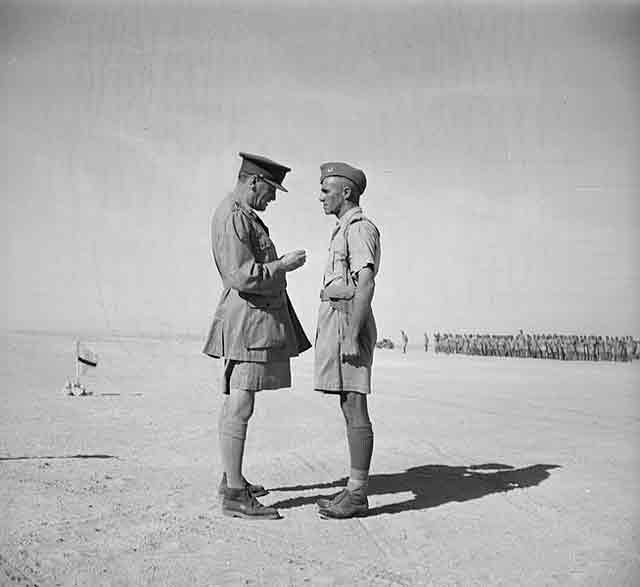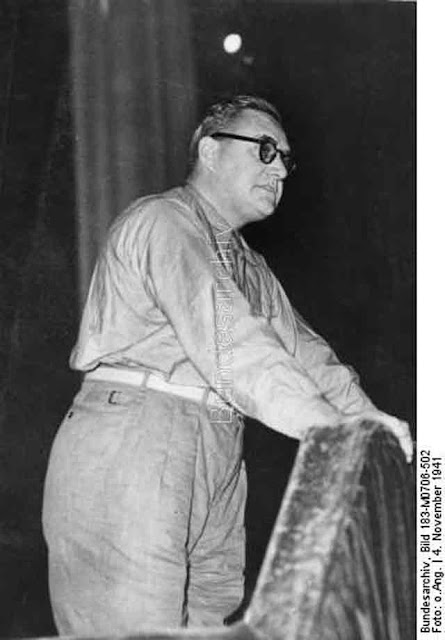Tuesday 4 November 1941
 |
| The Hunt Class destroyer HMS BROCKLESBY, passing a target towed by HMS ELLESMERE. 4 November 1941 (© IWM (A 6228)). |
 |
| A soldier using a Degtyaryov antitank rifle, November 1941 (Plenik, Bruno, Federal Archive Bild 101I-141-1273-24A). |
Eleventh Army continues its advance although the mountainous terrain around Sevastopol is affording the enemy greater opportunities for resistance.While General von Manstein's 11th Army is finding that Sevastopol is going to be a hard nut to crack, further east the 170th Infantry Division expands the German hold on the Crimea by taking Feodosiya at the base of the Kerch peninsula. The Soviets have withdrawn in good order to a short line defending Kerch which leaves Sevastopol in the west completely isolated. However, both Red Army redoubts are well-garrisoned and easy to defend due to natural terrain features.
Despite the overwhelming difficulties of movement, we must find means to occupy the areas evacuated by the enemy.The problems are a little more subtle:
Viewed as a whole, the situation is determined by railroad capacity and flow of supplies. There is no point in pushing operations onward before we have not, step by step, established a solid foundation for them. Failing to do that inevitably would bring fatal reverses down upon us.These words would be well worth remembering in late 1942 when Soviet retreats will also create tempting opportunities.
 |
| General Auchinleck, Commander in Chief of the Middle East Forces, decorating Lieutenant Colonel Howard Karl Kippenberger with the Distinguished Service Order during a presentation of awards to members of a New Zealand brigade in the Western Desert. Taken at Baggush on 4 November 1941 by an official photographer. |
 |
| Jacques Doriot at a meeting in Paris on 4 November 1941. Doriot is a former communist who became a fascist in the 1930s. He is a strong collaborator and a founder of the Légion des Volontaires Français (LVF), a French unit of the Wehrmacht, with which Doriot fights in 1941 on the Eastern Front (Federal Archives 4 November 1941 Figure 183-M0706-502). |
 |
| "A mechanic attaches the cable of a trolley-accumulator to a Hawker Hurricane Mark IIB of No. 81 Squadron RAF on the waterlogged airfield at Vanga, as a section of three Hurricanes flies overhead." Vanga, Russia, September/November 1941 © IWM (CR 38). |
November 1941
November 1, 1941: Finns Attack Toward Murmansk Railway
November 2, 1941: Manstein Isolates Sevastopol
November 3, 1941: Japan Prepares to Attack
November 4, 1941: German Advances in the South
November 5, 1941: Last Peace Effort By Japan
November 6, 1941: Stalin Casts Blame in an Unexpected Direction
November 7, 1941: Stalin's Big Parade
November 8, 1941: Germans Take Tikhvin
November 9, 1941: Duisburg Convoy Destruction
November 10, 1941: Manstein Attacks Sevastopol
November 11, 1941: Finland's Double Game Erupts
November 12, 1941: T-34 Tanks Take Charge
November 13, 1941: German Orsha Conference
November 14, 1941: German Supply Network Breaking Down
November 15, 1941: Operation Typhoon Resumes
November 16, 1941: Manstein Captures Kerch
November 17, 1941: Finland Halts Operations
November 18, 1941: British Operation Crusader
November 19, 1941: Sydney vs. Kormoran Duel
November 20, 1941: The US Rejects Final Japanese Demand
November 21, 1941: Germans Take Rostov
November 22, 1941: Kleist in Trouble at Rostov
November 23, 1941: Germans Take Klin, Huge Battle in North Africa
November 24, 1941: Rommel Counterattacks
November 25, 1941: HMS Barham Sunk
November 26, 1941: Japanese Fleet Sails
November 27, 1941: British Relieve Tobruk
November 28, 1941: Rostov Evacuated, German Closest Approach to Moscow
November 29, 1941: Hitler Furious About Retreat
November 30, 1941: Japan Sets the Date for its Attack
2020

No comments:
Post a Comment